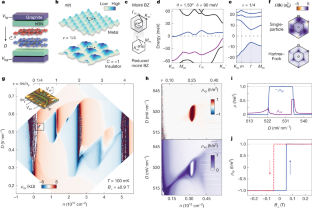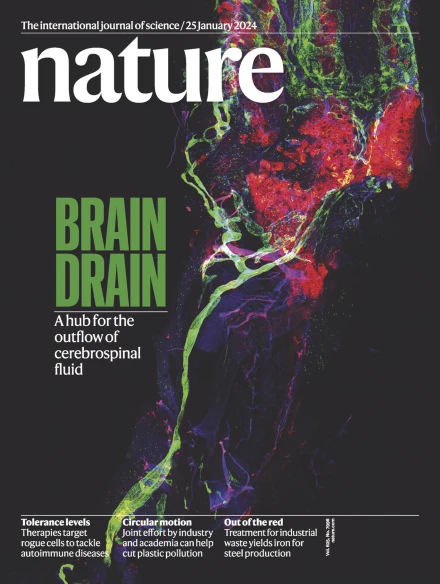Moiré-driven topological electronic crystals in twisted graphene
IF 50.5
1区 综合性期刊
Q1 MULTIDISCIPLINARY SCIENCES
引用次数: 0
Abstract
In a dilute two-dimensional electron gas, Coulomb interactions can stabilize the formation of a Wigner crystal1–3. Although Wigner crystals are topologically trivial, it has been predicted that electrons in a partially filled band can break continuous translational symmetry and time-reversal symmetry spontaneously, resulting in a type of topological electron crystal known as an anomalous Hall crystal4–11. Here we report signatures of a generalized version of the anomalous Hall crystal in twisted bilayer–trilayer graphene, whose formation is driven by the moiré potential. The crystal forms at a band filling of one electron per four moiré unit cells (ν = 1/4) and quadruples the unit-cell area, coinciding with an integer quantum anomalous Hall effect. The Chern number of the state is exceptionally tunable, and it can be switched reversibly between +1 and −1 by electric and magnetic fields. Several other topological electronic crystals arise in a modest magnetic field, originating from ν = 1/3, 1/2, 2/3 and 3/2. The quantum geometry of the interaction-modified bands is likely to be very different from that of the original parent band, which enables possible future discoveries of correlation-driven topological phenomena. We report signatures of a generalized version of the anomalous Hall crystal in twisted bilayer–trilayer graphene, whose formation is driven by the moiré potential.


扭曲石墨烯中莫伊兰驱动的拓扑电子晶体
在稀薄的二维电子气体中,库仑相互作用可以稳定维格纳晶体的形成。虽然维格纳晶体在拓扑上是平凡的,但据预测,部分填充带中的电子可以自发地打破连续的平移对称性和时间反转对称性,从而产生一种被称为反常霍尔晶体的拓扑电子晶体4,5,6,7,8,9,10,11。在这里,我们报告了扭曲的双层-三层石墨烯中异常霍尔晶体的广义版本的特征,其形成是由莫尔阱势驱动的。晶体形成于每4个摩尔粒子(ν = 1/4)有1个电子的带填充,使单位细胞面积增加了4倍,与整数量子反常霍尔效应相一致。态的陈恩数是特别可调的,它可以在电场和磁场的作用下在+1和- 1之间可逆地切换。其他几个拓扑电子晶体出现在适度的磁场中,起源于ν = 1/3, 1/2, 2/3和3/2。相互作用修饰能带的量子几何可能与原始母能带的量子几何非常不同,这使得可能在未来发现相关驱动的拓扑现象。
本文章由计算机程序翻译,如有差异,请以英文原文为准。
求助全文
约1分钟内获得全文
求助全文
来源期刊

Nature
综合性期刊-综合性期刊
CiteScore
90.00
自引率
1.20%
发文量
3652
审稿时长
3 months
期刊介绍:
Nature is a prestigious international journal that publishes peer-reviewed research in various scientific and technological fields. The selection of articles is based on criteria such as originality, importance, interdisciplinary relevance, timeliness, accessibility, elegance, and surprising conclusions. In addition to showcasing significant scientific advances, Nature delivers rapid, authoritative, insightful news, and interpretation of current and upcoming trends impacting science, scientists, and the broader public. The journal serves a dual purpose: firstly, to promptly share noteworthy scientific advances and foster discussions among scientists, and secondly, to ensure the swift dissemination of scientific results globally, emphasizing their significance for knowledge, culture, and daily life.
 求助内容:
求助内容: 应助结果提醒方式:
应助结果提醒方式:


